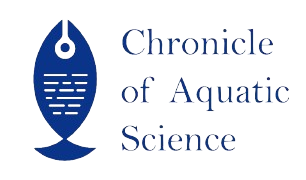| File | Action |
|---|---|
| Application of CRISPR-Cas9 in Fisheries as a Genetic Tool for Future Aspects | Download |
- 919088951040 call us
- chronicleofaquaticscience@gmail.com Mail us
CoASV3IS103
Application of CRISPR-Cas9 in Fisheries as a Genetic Tool for Future Aspects
Sumit Mallick, Janmejay Parhi, N.C. Devi and Pallavi Yadav*
Abstract
The CRISPR-Cas system, initially discovered in 1987, has revolutionized biotechnology, medicine, and chemical biology since its widespread adoption in 2013.
Its unique target specificity, enabled by guide RNA (gRNA), has facilitated diverse applications in genome editing, gene therapy, molecular diagnostics, and basic research. The system consists of CRISPR arrays and Cas proteins, operating through distinct stages of adaptation, expression, maturation, and interference in prokaryotic immune systems. Recent advancements include applications in fisheries, such as pathogen detection and diagnostics for diseases like TiLV and WSSV, as well as genome editing of commercially significant fish species to enhance traits like growth and disease resistance. Notable breakthroughs include the rapid development of genetic mutant breeds and efficient sgRNA design for precise genome editing. Future prospects highlight CRISPR's potential in healthcare and agriculture while emphasizing ethical considerations to mitigate environmental risks associated with genetically modified organisms. The CRISPR-Cas9 system underscores transformative possibilities in research, aquaculture, and conservation biology, necessitating responsible and sustainable applications.
Its unique target specificity, enabled by guide RNA (gRNA), has facilitated diverse applications in genome editing, gene therapy, molecular diagnostics, and basic research. The system consists of CRISPR arrays and Cas proteins, operating through distinct stages of adaptation, expression, maturation, and interference in prokaryotic immune systems. Recent advancements include applications in fisheries, such as pathogen detection and diagnostics for diseases like TiLV and WSSV, as well as genome editing of commercially significant fish species to enhance traits like growth and disease resistance. Notable breakthroughs include the rapid development of genetic mutant breeds and efficient sgRNA design for precise genome editing. Future prospects highlight CRISPR's potential in healthcare and agriculture while emphasizing ethical considerations to mitigate environmental risks associated with genetically modified organisms. The CRISPR-Cas9 system underscores transformative possibilities in research, aquaculture, and conservation biology, necessitating responsible and sustainable applications.
Keywords
Applications,CRISPR/Cas9,Classes and Future Aspects
Reference
Barrangou, R., Fremaux, C., Deveau, H., Richards, M., Boyaval, P., Moineau, S., Romero, D.A. and Horvath, P. (2007). CRISPR provides acquired resistance against viruses in prokaryotes. Sci, 315(5819): 1709-1712.
Behera, B.K., Pradhan, P.K., Swaminathan, T.R., Sood, N., Paria, P., Das, A., Verma, D.K., Kumar, R., Yadav, M.K., Dev, A.K. and Parida, P.K., 2018. Emergence of tilapia lake virus associated with mortalities of farmed Nile tilapia Oreochromis niloticus (Linnaeus 1758) in India. Aquaculture, 484: 168-174.
Bhardwaj, P., Kant, R., Behera, S.P., Dwivedi, G.R. and Singh, R. (2022). Next-Generation Diagnostic with CRISPR/Cas: Beyond Nucleic Acid Detection. Int. J. Mol. Sci., 23(11): 6052.
Bier, E. (2021). Gene drives gaining speed. Nat. Rev. Genet., 6:1–18.
Chaijarasphong, T., Thammachai, T., Itsathitphaisarn, O., Sritunyalucksana, K. and Suebsing, R., 2019. Potential application of CRISPR-Cas12a fluorescence assay coupled with rapid nucleic acid amplification for detection of white spot syndrome virus in shrimp. Aquaculture, 512: 734-340.
Chen, Y.C. (2021). CRISPR based genome editing and removal of human vi- ruses. Prog. Mol. Biol. Transl. Sci., 179:93–116.
Cong, L. and Zhang, F. (2015). Genome engineering using CRISPRCas9 system. In Chromosomal mutagenesis (197-217). Humana Press, New York, NY.
Doench, J. G. (2018). Am I ready for CRISPR? A user's guide to genetic screens. Nat. Rev. Genet., 19(2), 67-80.
Doench, J. G., Fusi, N., Sullender, M. et al. (2016). Optimized sgRNA design to maximize activity and minimize off-target effects of CRISPR-Cas9. Nat. Biotechnol, 34(2), 184-191.
Doudna, J. A. and Charpentier, E. (2014). The new frontier of genome engineering with CRISPR-Cas9. Sci, 346(6213), 1258096.
Edvardsen, R. B., Leininger, S., Kleppe, L., Skaftnesmo, K. O. and Wargelius, A. (2014). Targeted mutagenesis in Atlantic salmon (Salmo salar L.) using the CRISPR/Cas9 system induces complete knockout individuals in the F0 generation. Plos one, 9(9), e108622.
Behera, B.K., Pradhan, P.K., Swaminathan, T.R., Sood, N., Paria, P., Das, A., Verma, D.K., Kumar, R., Yadav, M.K., Dev, A.K. and Parida, P.K., 2018. Emergence of tilapia lake virus associated with mortalities of farmed Nile tilapia Oreochromis niloticus (Linnaeus 1758) in India. Aquaculture, 484: 168-174.
Bhardwaj, P., Kant, R., Behera, S.P., Dwivedi, G.R. and Singh, R. (2022). Next-Generation Diagnostic with CRISPR/Cas: Beyond Nucleic Acid Detection. Int. J. Mol. Sci., 23(11): 6052.
Bier, E. (2021). Gene drives gaining speed. Nat. Rev. Genet., 6:1–18.
Chaijarasphong, T., Thammachai, T., Itsathitphaisarn, O., Sritunyalucksana, K. and Suebsing, R., 2019. Potential application of CRISPR-Cas12a fluorescence assay coupled with rapid nucleic acid amplification for detection of white spot syndrome virus in shrimp. Aquaculture, 512: 734-340.
Chen, Y.C. (2021). CRISPR based genome editing and removal of human vi- ruses. Prog. Mol. Biol. Transl. Sci., 179:93–116.
Cong, L. and Zhang, F. (2015). Genome engineering using CRISPRCas9 system. In Chromosomal mutagenesis (197-217). Humana Press, New York, NY.
Doench, J. G. (2018). Am I ready for CRISPR? A user's guide to genetic screens. Nat. Rev. Genet., 19(2), 67-80.
Doench, J. G., Fusi, N., Sullender, M. et al. (2016). Optimized sgRNA design to maximize activity and minimize off-target effects of CRISPR-Cas9. Nat. Biotechnol, 34(2), 184-191.
Doudna, J. A. and Charpentier, E. (2014). The new frontier of genome engineering with CRISPR-Cas9. Sci, 346(6213), 1258096.
Edvardsen, R. B., Leininger, S., Kleppe, L., Skaftnesmo, K. O. and Wargelius, A. (2014). Targeted mutagenesis in Atlantic salmon (Salmo salar L.) using the CRISPR/Cas9 system induces complete knockout individuals in the F0 generation. Plos one, 9(9), e108622.
- Published online
- 15th March, 2025
How to Cite the Article
Mallick S, Parhi J, Devi NC and Yadav P. Application of CRISPR-Cas9 in Fisheries as a Genetic Tool for Future Aspects. Chron Aquat Sci. 2025; 3(1):10-14
Copyright
This is an open-access article distributed under the terms of the Creative Commons Attribution License (CC BY). The use, distribution or reproduction in other forums is permitted, provided the original author(s) and the copyright owner(s) are credited and that the original publication in this journal is cited, in accordance with accepted academic practice. No use, distribution or reproduction is permitted which does not comply with these terms.

CoASV3IS103


